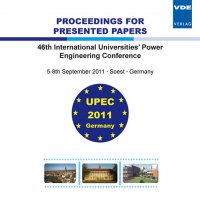The Influences of Decoupling Elements on the Testing of Low Voltage Spark Gap and Varistor
Conference: UPEC 2011 - 46th International Universities' Power Engineering Conference
09/05/2011 - 09/08/2011 at Soest, Germany
Proceedings: UPEC 2011
Pages: 5Language: englishTyp: PDF
Personal VDE Members are entitled to a 10% discount on this title
Authors:
Waluyo; Hutasoit, Yan Maret (Alumnus at Electrical Engineering Department, National Institute of Technology, Bandung, Indonesia)
Abstract:
This paper presents the research results of the influence of decoupling elements as representation of inductive property. The main equipment of the research were impulse generator, spark gap and varistor arresters as protective devices, storage oscilloscope and wires. The impulses were injected to the arresters through the decoupling elements, and recorded by the oscilloscope. The decoupling elements consisted of three types, namely ferrite, iron and air core decoupling elements. The wires those wound on the cores were made of copper. The results indicated that the inductances and capacitances for ferrite, iron and air cores were 133.6 microH and 8.0 microF, 14.7 microH and 38.6 microF and 2.2 microH and 27.99 microF respectively. Based on the oscilloscope display, the first, second and third highest oscillations of the impulse voltages were for the ferrite, iron and air cores of the decoupling elements respectively. As an addition, the impedance of the ferrite core decoupling element was the highest among other decoupling elements. Therefore, the ferrite core decoupling element was the most suitable for an impediment the surge overvoltages.


